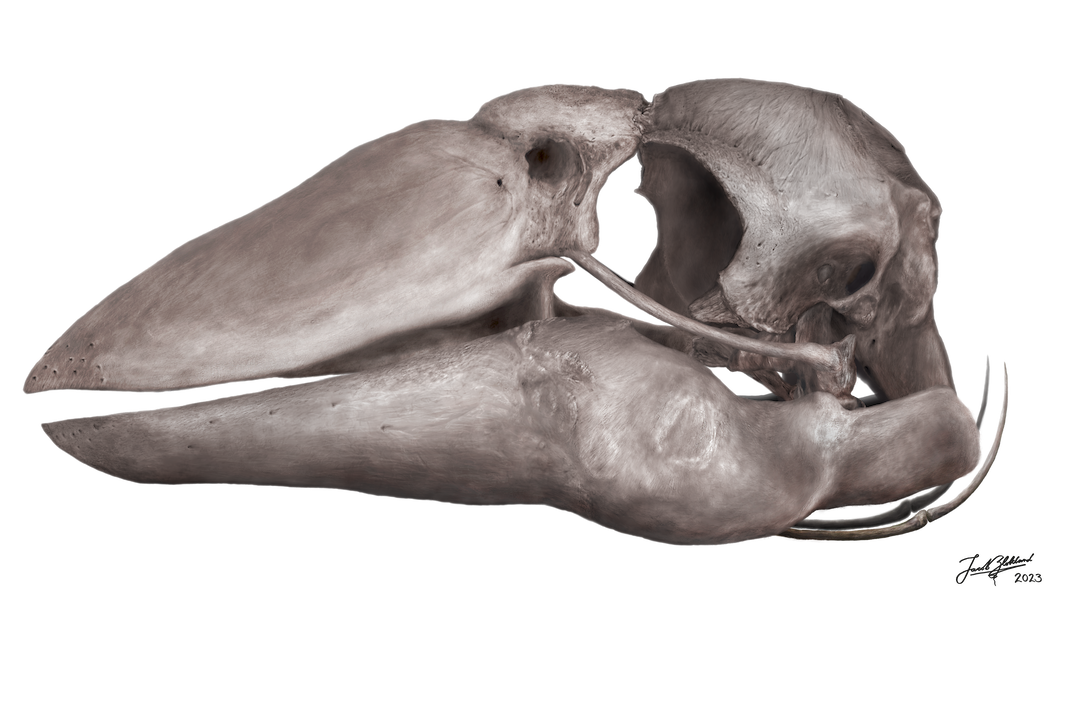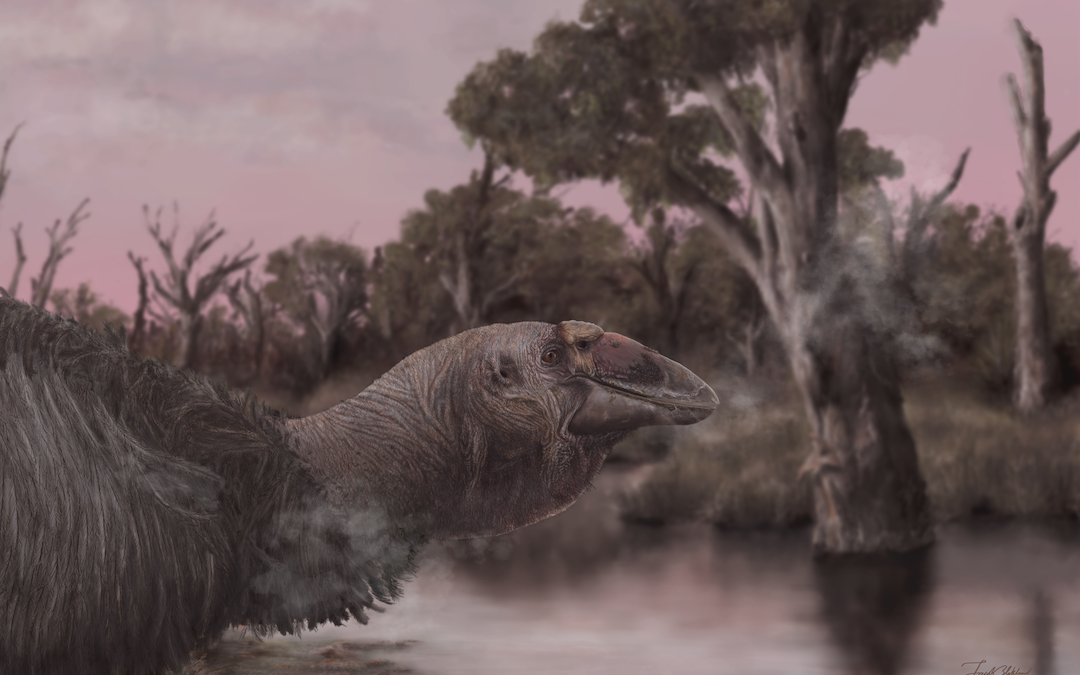Researchers from Flinders University have unearthed a nearly complete skull of the extinct Genyornis newtoni: an immense prehistoric bird that once roamed Australia.
For over a century, the true appearance of Genyornis newtoni – known as mihirung paringwal (meaning ‘giant bird’ from the Djab Wurrung mob) or the ‘thunder bird’ – has eluded scientists. This enormous, flightless bird stood two metres tall and weighed up to 230 kilograms – around five times the weight of the Southern Cassowary.
It was just one species of megafauna that existed in Australia, alongside three ton wombat-like Diprotodons and 4.5-metre-long venomous goannas known as Megalania.
Opening image: Illustration by Jacob C. Blokland. Used with permission. Available for media and current affairs use; all other rights reserved.

The proposed relationships of Genyornis newtoni within the waterfowl clade with a size comparison of Genyornis to it closest relative, Anhima cornuta and non-related Cassowary. Illustration by Phoebe McInerney. Used with permission. Available for media and current affairs use; all other rights reserved.
The discovery
The first and only previously known Genyornis skull, reported in 1913, was severely damaged, leaving much to speculation about the thunder bird’s appearance. Today, thanks to scientists’ exploration and advanced palaeontological techniques, the mystery has been solved.
During field trips to the remote region of Lake Callabonna in South Australia, a team led by PhD candidate Phoebe McInerney made a groundbreaking discovery in 2019. Among the fossil remains was a near-complete skull of Genyornis newtoni, which allowed researchers to reconstruct the bird’s appearance for the first time.
These findings were published in the journal Historical Biology.

An artistic reconstruction of the skull of Genyornis newtoni in articulation, based on the fossil material. Illustration by Jacob C. Blokland. Used with permission. Available for media and current affairs use; all other rights reserved.
The skull
Genyornis and its cousins in the family Dromornithidae (known as dromornithids) have unusually large skulls for flightless birds. The tall skull features a short braincase attached to a large and robust lower jaw, which first gave it its name: Genyornis roughly translates to “jaw bird” in Greek.
Genyornis, however, is set apart from other dromornithids by its distinctive upper jaw. A tall ridge runs down the centre of the beak, and a bulbous structure called a casque is positioned in front of the eyes, above the small nostrils. The casque’s purpose is unknown but it might have been for sexual display.
“Genyornis newtoni had a tall and mobile upper jaw like that of a parrot but shaped like a goose, a wide gape, strong bite force, and the ability to crush soft plants and fruit on the roof of their mouth,” says McInerney.
The detailed study of the skull morphology enabled researchers to infer how Genyornis’ head functioned, including muscle placement and movement. Jacob Blokland, a co-author, was then able to create a scientifically accurate reconstruction of Genyornis.
He explains: “The form of a bone, and structures on it, are partly related to the soft tissues that interact with them, such as muscles and ligaments, and their attachment sites or passages. Using modern birds as comparatives, we are able to put flesh back on the fossils and bring them back to life.”
The intricate and complex similarities between Genyornis and early waterfowl, such as the South American Screamers and the Australian Magpie Goose, provided important clues for understanding the evolutionary lineage of Genyornis.
“The exact relationships of Genyornis within this group have been complicated to unravel, however, with this new skull we have started to piece together the puzzle which shows, simply put, this species to be a giant goose,” she says.

Phoebe McInerney and Jacob Blokland with a skull of Genyornis newtoni.
Adaption and extinction
Blokland’s reconstruction revealed not only the bird’s formidable appearance but also adaptations for an aquatic habitat. The enclosed palate, rear-positioned nostrils and ear protection all help to prevent water inflow and limit hearing interference while feeding submerged.
These features indicate Genyornis had adapted to thrive around swamps, wetlands and lakes. However, as the Australian continent began to dry out around 50,000 years ago, these wetlands began to shrink and vegetation patterns changed. The bodies of freshwater once present in northern South Australia are now mostly dry salt lakes.
While Genyornis was able to move across open ground between bodies of water using their broad, short toes and hoof-like claws, their reliance on freshwater and new plant growth would have made survival more difficult as ponds and lakes shrunk and disappeared. It is thought that Genyornis became extinct around 45,000 years ago.
This may not be the whole story, but as McInerney points out, “The drying of the Australian continent likely played a significant role in the demise of Genyornis and other dromornithids.”
While these megafauna are no longer with us, the discovery of Genyornis newtoni’s skull marks a significant milestone in palaeontology, offering a window into the life of one of Australia’s most intriguing prehistoric creatures.
For more on amazing scientific discoveries in Australia, check out the discovery of a new species of pterosaur.

